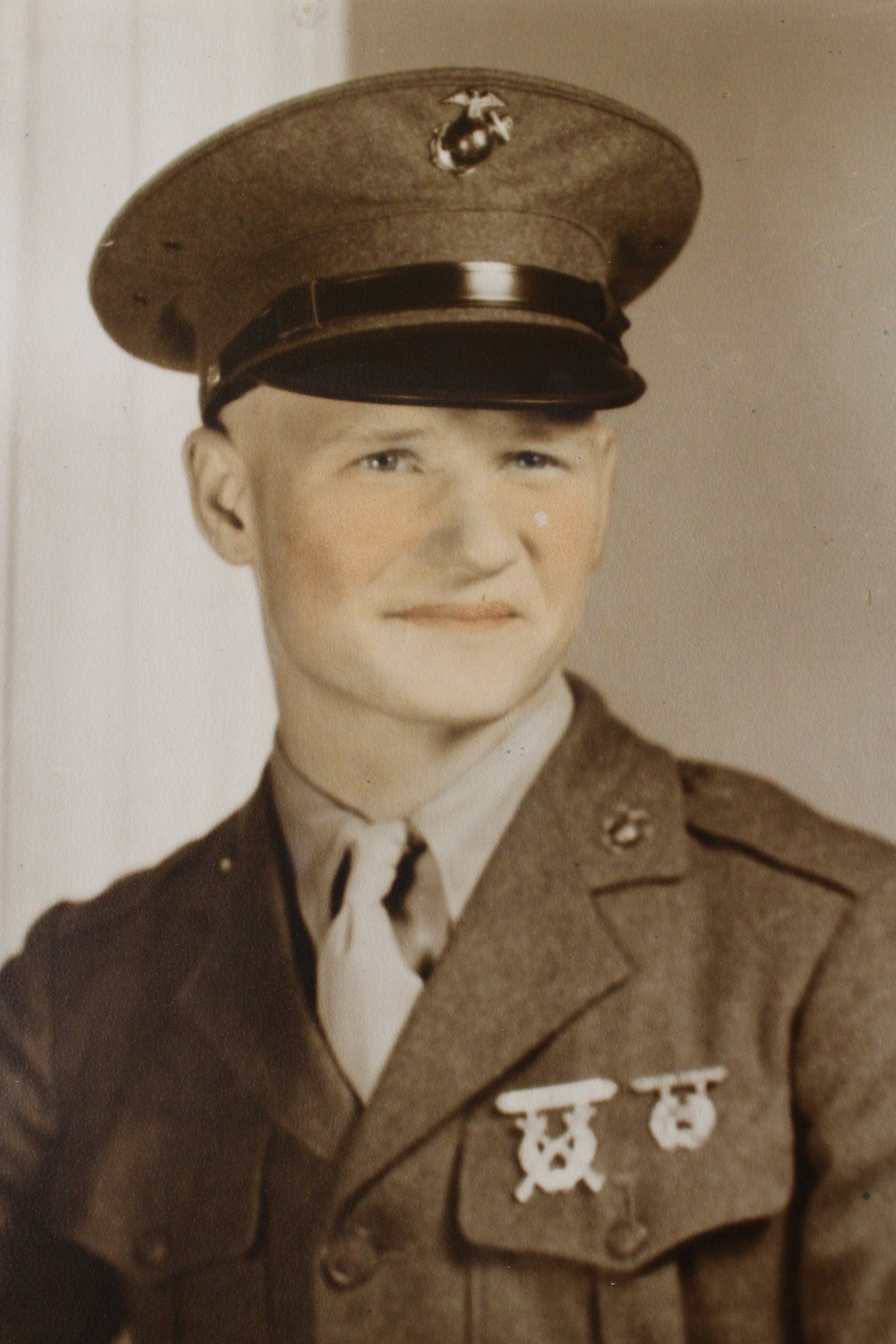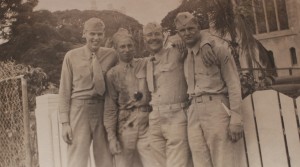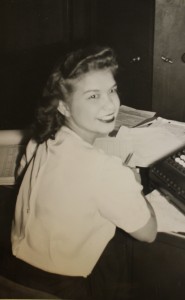When the Japanese attacked on Pearl Harbor in 1941, Richard Simpson was only seventeen years old. Just days after his eighteenth birthday in September of 1942, he enlisted in the United States Marine Corps, and after twelve weeks of basic Marine training he shipped off to Pearl Harbor. There, he remained on guard duty until he volunteered for a position on the USS Colorado, one of the largest battleships of the time. The USS Colorado played a key role in achieving victory over Japan in World War II due to her roles in several key battles, especially the Battle of Leyte Gulf in 1944.
Richard recalls several stories of his time on the USS Colorado. He stated that most of the time, the battleship simply sailed around waiting for something to happen. Any action that they received usually only lasted about thirty minutes, and then was followed by days of silence. He describes it very much as a “hurry up and wait” situation. To pass the time, the sailors found many ways to keep boredom at bay. He said that sometimes his friends would find ways to swipe food from the officers mess hall, which was of higher quality than the food served to the enlisted men. He tells of hours spent steaming shrimp in the bathroom and mixing together a whole concoction of ingredients to act as a sauce. He also remembers late night shifts where the electrician mates on the lower decks invited him down for ham and egg sandwiches, a luxury that he had not been granted since he left his home in Michigan [1].
Another one of Richard’s stories involved the USS Colorado stopping for a relaxation day at a United States-occupied island. He said that once they were on shore, every person was given the chance to have three cans of beer. The people giving out the beer noted the person’s name, ship, and detachment. Richard recollects that some of his friends obtained as many as twelve beers by simply changing what Marine detachment number they stated. He remembers commanding officers becoming confused at the level of intoxication of their returning Marines [1].

Richard Simpson’s Story
Richard (pictured on the right) grew up as the youngest child and only son of the Simpson family. His mother died during childbirth, and his father died during Richard’s childhood years. This left his step-mother alone to raise him with his three half sisters while also managing the Detroit-based, family business called “Simpson Granite”. Richard eventually took over the family granite business after his three years in the active duty Marine Corps serving in the Pacific theater during WWII.
During his time as a Marine, Richard served at several different naval bases around the United States. He went to basic training in San Diego, California where the majority of Marines entering into the Pacific fleet completed their training throughout the 1940’s. Simpson graduated at the top of his platoon for riflery skills, which remains impressive when considering he had never touched a gun before his training. Marine training included intense trials and upheld extremely high standards during their war-time training. According to Richard, the sergeants would walk around with so-called “swagger sticks” and would administer “sharp pokes to the stomach” should the recruits fail to uphold standards of adequate performance [1]. After twelve full weeks of training, each recruit was assigned their position within the Marine Corps, and Richard was assigned to guard duty in Hawaii. Pictured on the right is Richard and his graduating class out of San Diego in 1942.

After graduating from basic training, Richard moved on to his post at Pearl Harbor in Hawaii. There, he served on guard duty for eight months. The Marine guards stationed at Pearl Harbor were in charge of guarding oil tanks, ammunition dumps, ships in dry dock and various other posts such as entrances and exits around the base. Guard duty remains the equivalent of security forces or military police in other branches. After several months, Richard desired to utilize his skill set more directly in war operations, so he volunteered to join the crew of the USS Colorado in 1942. Shown on the left are Richard and several of his crew mates on the USS Colorado.

Richard held a special position as a Marine on a battleship [2]. In general, battleships in the Pacific front held around 70 Marines. The rest of the 1080 sailors on his battleship were seamen in the Navy. His particular battle station on the USS Colorado was one of the ship’s four 20mm anti-aircraft guns. He was chosen for a gunner position because of his high placement in basic training riflery skills. He remained on the USS Colorado until the end of the war in Japan, which happened to fall on his 21st birthday on September 2, 1945. From there, he sailed back to San Francisco, and returned to Michigan to take over the family business. Fairly soon after he took over the family business, he married his wife, Kathleen (pictured on the right).

USS Colorado History
Richard Simpson served on the USS Colorado from 1942 to 1945, but the history of the battleship dates back to its commissioning into the United States Navy on August 30, 1923 under Captain Reginald Belknap [4]. The Colorado was the first ship in its class (called the Standard Colorado-class), which proved a unique innovation at the time since they carried eight 16″ guns, twelve 5″ guns and four 3″ anti-aircraft guns. With on-going technological advancements in battleships engines, the USS Colorado showed extreme improvement on the older classes in terms of fuel efficiency and attack ability. Shortly before the attack on Pearl Harbor, she was fitted with what was known as a “torpedo bulge” which gave the ship stronger defensive advantages over torpedoes [9]. Essentially, served as armor for a battleship, creating a place that could be struck by a torpedo and not damage any of the internal components of the ship. More improvements were planned for her, but when Pearl Harbor was attacked, every working ship was called to service and the planned improvements were forgotten as she sailed towards Asia. In fact, the USS Colorado was the only battleship to emerge from the attack on Pearl Harbor unscathed, as she was out on a training exercise that day [11]. Of the eight battleships in the fleet that were present at Pearl Harbor, five (USS Oklahoma, USS West Virginia, USS Arizona, USS Nevada and the USS California) eventually sank because of the Japanese attack, two (USS Tennessee and USS Maryland) required minor repairs, but still remained afloat, and one (USS Pennsylvania) was in dry docks and only required cosmetic repairs [13].
In World War II, the USS Colorado was a part of the Pacific fleet, originally referred to as the Battle Fleet. Generally grouped together with the USS Tennessee and the USS Maryland, the USS Colorado aided in operations involving the Pacific islands. Richard sailed around on the Colorado to various locations acting as one of the ship’s anti-aircraft gunners. Richard stated that specific attention was given to kamikaze pilots, as they were unlike anything the United States had ever dealt with in the past. The gunners were instructed to continue shooting until the planes were in the water, because the pilots would not simply return to their bases if they faced mechanical damage, as aircraft of other nations might do. The USS Colorado served as both a means of transporting the Marines as well as their support system from the sea. In fact, according to the USS Colorado’s official website, the mission of the ship was to “destroy fortifications along the beaches and support assault waves by pounding the enemy troop areas immediately adjacent to the landing points” [12]. The USS Colorado accomplished her mission, which made her a crucial part of the fighting force in both the Philippines and the Japanese Islands.
The USS Colorado was a major player in the strategic Island Hopping campaign. From where the ship picked up Richard at Pearl Harbor, she sailed to the Fiji Islands to help stop Japanese influence in the greater Asia area. She continued on and made stops in the Gilbert Islands, which are in a prime geographic location between Japan and Hawaii [5]. In early 1944, she returned to Hawaii shortly and continued on to Saipan, Guam, and the Mariana Islands. Whilst at the Mariana Islands, the USS Colorado took heavy damage from Japanese on shore artillery which forced a return to Pearl Harbor for minor repairs. After repairs, she sailed back to Asian islands, but was hit by two Japanese kamikaze pilots which caused almost 100 casualties. After a few more months of island defense, including a stops at Lingayen Gulf and Okinawa, she sailed into Tokyo Bay on September 2, 1945 (Richard’s 21st birthday) for the signing of the armistice, then returned back to San Francisco with the rest of the Pacific Fleet [6].
The Battle of Leyte Gulf in October of 1944 marked the beginning of United States’ domination over Japan, and the USS Colorado played a key strategic role in this important turning point. Considered the largest naval battle of the war in the Pacific, The Battle of Leyte Gulf remains one of the Joint Chiefs of Staffs’ riskier moves in the Island Hopping campaign, but it ended in overwhelming success. The USS Colorado had been stationed in the gulf providing naval support to the American troops fighting on the ground. Richard was posted at his battle station, firing his 20mm anti-aircraft gun. It was during this time that Japan, in a desperate attempt to destroy American forces, instructed two kamikaze pilots to crash into the USS Colorado. That attack resulted in 19 crew deaths and 72 crew injured [7]. However, the kamikazes remained unsuccessful in their attempts to completely destroy the USS Colorado as she continued to fight. Finishing the Leyte Gulf invasion and moving on to fight the battle of Lingayen Bay several weeks later, the USS Colorado’s contributions and resilience remained one of the many details that led the United States to victory that day [8]. Without the success in the Battle of Leyte Gulf, the United States may have needed to allocate a significantly greater amount of time and resources into obtaining victory on the Pacific front.

Conclusions
The USS Colorado remained a crucial roles in key battles such as the Battle of Leyte Gulf and the taking over of the Gilbert Islands, making the USS Colorado and her crew one of the most formidable forces on the World War II Pacific front. One of Richard’s’ shipmates, Petty Officer First Class Bill Reichardt, described leaving Tokyo Bay on November 11, 1945 as “a thrill… it was over now and we could go home,” [3]. Everyone breathed a sigh of relief as every ship in the naval fleet left Japan and started moving towards San Francisco Bay.
After sailing into San Fransisco, it did not take long for Richard to move back to Detroit. He then took over the family business from his step-mother. Simpson Granite still operates today and creates monuments, benches, ledgers, mausoleums, bird baths, and gravestones [10]. While Richard owned the business, one specialty project he worked on was a sarcophagus for Edsel Ford (the brother of Henry Ford). Day to day, he worked mostly on projects involving turning large slabs of granite into memorials and headstones. Richard sold the business in 1988 to David Blake and his partner Richard Reichenbach. Mr. Blake died several years ago and Mr. Reichenbach now owns the company [10].
Overall, Richard’s stories focused largely about the positive events that occurred during the war and the camaraderie that he shared with his fellow shipmates. However, Richard admits to becoming deeply troubled with the more difficult aspects of his job during this time. As mentioned above, the USS Colorado took massive hits from Japanese on shore battery whilst at the Mariana Islands. That, coupled with kamikaze attacks during the Battle of Leyte Gulf meant that of the seventy Marines that boarded the USS Colorado with Richard, only fifteen returned home safe and unscathed. Richard and his family remain thankful and proud that he returned safe and sound to Michigan and that he did his part to help ensure the victory over Japan.
Primary Sources:
- Simpson, Richard., “Oral History of My Experiences on the USS Colorado”. Transcript of an oral history conducted 2017 by Riley Simpson, MHUGL History Project, Michigan Technological University, Houghton, MI, 2017.
- Simpson, Richard E. Letter to Riley Simpson. 29 Nov. 2008. MS. 2.
- Bill Reichardt Collection (AFC/2001/001/70058), Veterans History Project, American Folklife Center, Library of Congress.
Secondary Sources:
- Hickman, Kennedy (2017). “World War II: USS Colorado (BB-45).“ ThoughtCo. Web
- The Editors of Encyclopaedia Britannica (2013). Gilbert Islands. Web.
- Chen, Peter. “USS Colorado,” World War 2 Database. Web.
- United States Navy (2016). “Colorado III BB-45.” Web.
- Coakley, Robertw W. “World War II: The War Against Japan.” American Military History, United States Army, pp. 515–520.
- Rickard, J (20 April 2012), USS Colorado (BB 45) , History of War. Web.
- Reichenbach, Richard. “The History of Our Company.” Simpson Granite. N.P., n.d. Web.
- LoProto, Mark. “The Battleship That Wasn’t There: USS Colorado.” Visit Pearl Harbor. Visit Pearl Harbor, 16 Oct 2017. Web.
- Jones, Ken. “BB-45 History 1944-1947.” USS Colorado. N.p., n.d. Web
- Hone, Thoma C. “December 7, 1941: The Destruction of the Battle Line at Pearl Harbor.” Naval History Blog. Proceedings Magazine, 06 Dec. 2012. Web.
Further Reading:
- Revolvy USS Colorado (BB-45)
- NavSource BB-45 USS Colorado
- Library of Congress Veterans History Project Frequently Asked Questions (FAQs)

